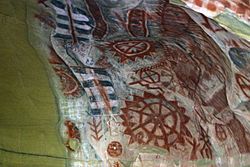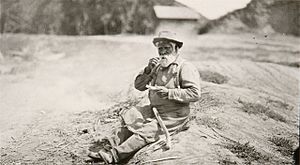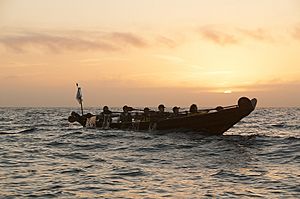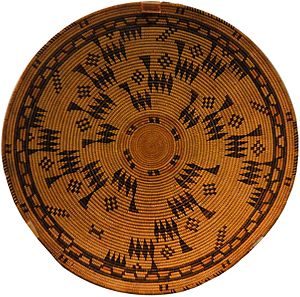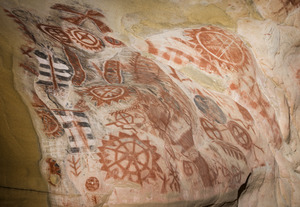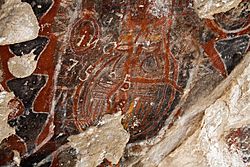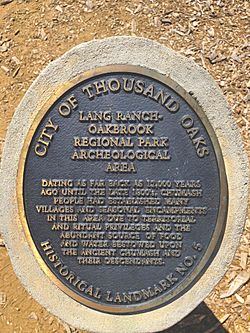Chumash people facts for kids
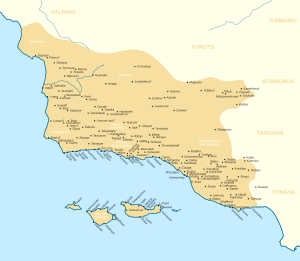
Historical Chumash villages
|
|
| Total population | |
|---|---|
| 2,000–5,000 | |
| Regions with significant populations | |
| Languages | |
| English • Spanish • formerly Chumashan languages | |
| Religion | |
| Traditional tribal religion, Christianity |
|
| Related ethnic groups | |
| Barbareño, Ventureño, Ineseño, Purisimeño, Obispeño |
The Chumash are a Native American people. They lived in the central and southern coastal areas of California. Their lands stretched from Morro Bay in the north to Malibu in the south. They also lived on three of the Channel Islands: Santa Cruz, Santa Rosa, and San Miguel.
Many places in California today have names that come from the Chumash language. These include Malibu, Nipomo, Lompoc, Ojai, Pismo Beach, Point Mugu, Port Hueneme, Piru, Lake Castaic, Saticoy, Simi Valley, and Somis.
Scientists who study old cultures (archaeologists) have found that the Chumash people have lived in the Santa Barbara Channel area for thousands of years.
Contents
History of the Chumash People
Life Before Europeans Arrived (Before 1542)
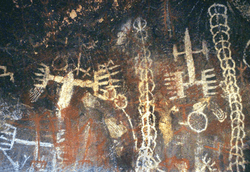
People have lived along the California coast for at least 11,000 years. The Chumash name means "bead maker" or "seashell people." This is because they lived near the Santa Barbara coast. The coastal Chumash had many resources. The ocean and land provided plenty of food.
Between 950 and 1300 AD, the ocean became even more productive. This led to a population growth among the Chumash. Before Europeans arrived, the Chumash lived in over 150 separate villages. They spoke different versions of the same language.
Their culture included making baskets and beads. They traded these items. They ate local seafood like abalone and clams. They also used plants for medicine (herbalism). They created amazing rock art. The "scorpion tree" was also important to them. It was a carving used to watch the stars and help with their calendar.
The Chumash lived in three main areas: the interior, the coast, and the Northern Channel Islands. The interior had wide plains, rivers, and mountains. The coast included cliffs and areas near the ocean. The Northern Channel Islands were off the coast. California's coast has a mild climate, which made gathering food easy. In winter, they ate stored foods.
Coastal and island Chumash were skilled at fishing. They used advanced canoes to catch fish and sea mammals far from shore. Shellfish like mussels, abalone, and clams were easy to find and a good food source. Red abalone shells were used to make fishhooks, beads, and decorations.
The Chumash were known for their tomol plank canoe. This special boat allowed them to catch deep-water fish like swordfish. It also helped them trade goods between villages.
Some people think that Polynesians might have visited the Chumash long ago. This would have been between 400 and 800 AD. The Chumash tomol canoe is similar to Polynesian canoes. However, most archaeologists do not believe this contact happened. They say the Chumash canoe developed over many centuries.
Chumash people living near the ocean ate more seafood. Those living inland ate more land animals. Deer were a very important animal for all Chumash. Inland Chumash even dressed as deer to hunt them. They also hunted smaller animals like rabbits and birds. Plant foods, especially acorns, were a main part of their diet. Acorns had to be prepared to remove toxins. They were ground into a paste that could be stored for years.
Spanish Contact and Missions (1542–1834)
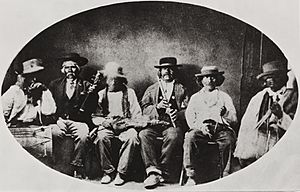
The first European to meet the coastal California tribes was Juan Cabrillo in 1542. Spain claimed California but did not return to settle until 1769. Spanish soldiers and missionaries arrived to convert Native Americans to Christianity and colonize the land.
The arrival of Europeans brought big changes for the Chumash. Spanish missions were built along the coast. The Chumash people were forced to move from their villages to these missions.
The first mission in Chumash lands was Mission San Luis Obispo, built in 1772. Other missions followed, including Mission San Buenaventura (1782), Mission Santa Barbara (1786), Mission La Purisima Concepción (1789), and Santa Ynez (1804). Many Chumash from the Channel Islands moved to the mainland missions by 1816.
Mexican Era (1834–1848)
In 1834, Mexico took control of the missions. Many Chumash people fled inland or were forced to work on large Mexican ranches. After 1849, much of the Chumash land was lost. Their population also decreased due to violence and disease.
In 1855, a small piece of land (120 acres) was set aside for about 100 Chumash people near Santa Ynez mission. This became the only Chumash reservation. Today, the Santa Ynez band lives there. In the late 1700s, the Chumash population was between 10,000 and 18,000. By 1900, it had dropped to only 200.
American Era (1848–Present)
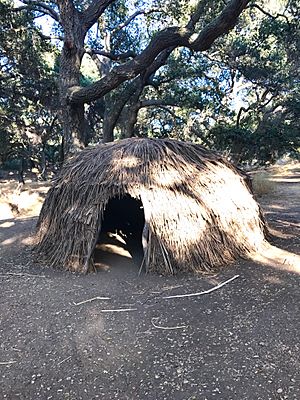
The Chumash reservation was officially established in 1901. It covers 127 acres. The last native speaker of a Chumash language, Mary Yee, died in 1965. Today, there are an estimated 5,000 Chumash members. Many can trace their family history to the Channel Islands.
Starting in the 1970s, new groups of Chumash people emerged. They work to promote Chumash traditions.
In 1976, the first modern tomol was built. It was named Helek/Xelex, meaning "falcon." The Brotherhood of the Tomol was restarted. Its crew paddled around the Santa Barbara Channel Islands on a 10-day trip. A second tomol, the Elye'wun ("swordfish"), was launched in 1997.
On September 9, 2001, the first "crossing" from the mainland to the Channel Islands by tomol took place. The Elye'wun was paddled to Limuw (Santa Cruz Island). This journey was shown in a short film called "Return to Limuw." These channel crossings are now a yearly event.
The Santa Ynez Band of Chumash is a federally recognized Chumash tribe. They have the Santa Ynez Reservation in Santa Barbara County. Some Chumash people are also part of the Tejon Indian Tribe of California. Other Chumash groups are working to gain federal recognition.
In 2008, the first Chumash dictionary was published. It is 600 pages long and has 4,000 entries. The documentary film 6 Generations: A Chumash Family History features Mary Yee, the last speaker of the Barbareño Chumash language.
Produce Initiative
In 2010, the Santa Ynez Band of Chumash Indians Foundation gave a grant to the Foodbank of Santa Barbara County. This money helped the Foodbank provide more fruits and vegetables to local charities. They give out produce for free to encourage healthy eating.
The Foodbank also has a Kids’ Farmers' Market program. Volunteers teach children in after-school programs about nutrition and cooking. After cooking, kids get a bag of fresh produce to take home. This helps families eat healthy. The Santa Ynez Band of Chumash also started a community garden in 2013. It provides vegetables to the Elder's Council.
Chumash Worldview
The Chumash believed that "all things are, in different ways, alive, intelligent, dangerous, and sacred." They did not have a creation story like some other tribes. Instead, they believed the universe with its three layers had always existed. Humans live in the middle layer, which rests on two giant snakes. Earthquakes happen when these snakes move.
The middle layer is where humans and spirits live. Shamans could travel here during special spiritual journeys. This layer is connected to the lower world through springs and marshes. It is connected to the upper world through mountains. Water creatures were important because they were linked to the lower world's powers. They were often shown in rock art.
The upper world, called Alapay, is where the "sky people" lived. They were important for the health of the people. Key figures in the sky world include the Sun, the Moon, Lizard, Sky Coyote, and Eagle. The Sun was seen as a source of life, but also of disease.
Chumash Bands
The Santa Ynez Band of Chumash Mission Indians of the Santa Ynez Reservation is a federally recognized tribe. Other Chumash people are part of the federally recognized Tejon Indian Tribe. There are 14 known bands of Chumash Indians.
- Barbareño Chumash, linked to the Taynayan missions.
- Coastal Band of the Chumash Nation, from the coastal areas north of Los Angeles.
- Cuyama Chumash, from the Cuyama Valley.
- Island Chumash, from the Channel Islands.
- Kagismuwas Chumash, from the southwest part of Chumash land.
- Los Angeles Chumash, formed when people from Malibu, Tejon, and Ventura bands moved in the 1800s.
- Malibu Chumash, from the coast of Malibu.
- Monterey Chumash, from the Monterey Peninsula.
- Samala, or Santa Ynez Chumash. In 2012, they worked to get more land for housing and a cultural center.
- San Fernando Valley Chumash, who worked at the Mission San Fernando Rey de España.
- Yak Tityu Tityu Yak Tilhini Northern Chumash, from coastal Avila Beach to Morro Bay.
- Tecuya Chumash, an anti-colonial group who lived in Tecuya Canyon.
- Tejon Chumash, part of the Kern County Chumash Council.
- Ventura Chumash, who live in the traditional area of the Owl Clan.
Chumash Population
It is hard to know exactly how many Chumash people lived in California before Europeans arrived. Some experts think the population in 1770 was about 10,000. Others believe it was closer to 15,000 or even 18,500.
Some scholars think the Chumash population may have dropped before 1769. This could be due to diseases brought by Spanish ships. However, the Chumash seemed to be doing well in the late 1700s when the Spanish began colonizing. Later, the building of Spanish missions and the California Genocide caused a huge decline in their numbers. By 1900, only about 200 Chumash remained. Today, estimates of the Chumash population range from 2,000 to 5,000.
An interesting part of traditional Chumash society was the 'Aqi gender. 'Aqi were biological males who did work and wore clothes traditionally associated with women.
Chumash Languages
Several related languages, called "Chumash" languages, were spoken. The name "Chumash" comes from a word meaning "Santa Cruz Islander." No native speakers of these languages are alive today. However, linguists like John Peabody Harrington carefully recorded them. The Barbareño, Ineseño, and Ventureño languages are especially well documented.
In 2010, the Šmuwič Chumash Language School was started. Language classes were revived in 2014 and later moved online. The traditional name for Ineseño is s'amala, and the Chumash name for the Barbareño people is Šmuwič.
Chumash Culture
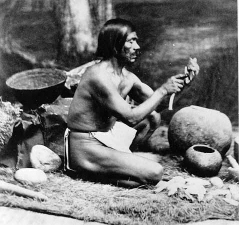
The Chumash were hunter-gatherers. They were very skilled at fishing when the Spanish arrived. They were one of the few groups in the New World who regularly traveled on the ocean. Some villages built special plank boats called tomol. These boats helped them trade goods and even hunt whales.
Basket Making
Scientists who study human cultures (anthropologists) have collected many Chumash baskets. Some of the largest collections are in museums in Washington, DC, and Paris. The Santa Barbara Museum of Natural History is thought to have the biggest collection of Chumash baskets.
Bead Making and Trading
The Chumash on the Northern Channel Islands were at the center of a large trade network. They made beads from Olivella shells. These shell beads were used as money by the Chumash. They traded these beads to other groups throughout California. Millions of shell beads were made and traded from Santa Cruz Island.
Chumash Food
The Chumash historically ate many kinds of seafood. These included black abalone, Pacific littleneck clams, red abalone, and various oysters. Acorns were a very important plant food. They were ground up and cooked into a soup. They also made flour from the dried fruits of the laurel sumac.
Herbal Medicine
The Chumash used many herbs for medicine. For example, they used thick-leaved yerba santa to help with breathing. The root bark of laurel sumac was used to make tea for treating stomach problems. They also used black sage. Its leaves and stems were made into a strong tea and rubbed on painful areas.
The Chumash also had a special ceremony for boys using a plant called sacred datura (mo'moy). When a boy was 8 years old, his mother would give him a drink made from it. This was meant to be a spiritual challenge to help him become a man. However, not all boys survived because the plant is poisonous.
Rock Art
You can still see amazing examples of Chumash culture today. These include rock paintings that show their beliefs about the universe. A great example is at Chumash Painted Cave State Historic Park.
Scorpion Tree
There is a very old oak tree in California with a special carving. It shows a six-legged creature with a crown and two spheres. This carving is called a Chumash arborglyph. Experts believe it was made by Chumash shamans. They may have used these carvings to watch the stars and help with their calendar.
Notable Chumash People
Here are some notable people of Chumash descent:
- Lorna Dee Cervantes (born 1954), an award-winning poet and activist.
- Deborah A. Miranda (born 1961), a writer and poet.
- John Olguin (1921–2011), former director of the Cabrillo Marine Aquarium.
- Rafael Solares (1822–1890), a Samala chief who shared cultural knowledge with scientists.
- Fernando Librado (1839–1915), an elder, master tomol builder, and storyteller.
- Mary Joachina Yee (1897–1965), a linguist and the last known speaker of the Barbareño language.
- Ernestine Ygnacio-De Soto, a Chumash activist and historian working to revive the Barbareño language.
- Semu Huaute (1908–2004), a medicine man and actor.
- Rosario Cooper (1845–1917), the last known fluent speaker of the tiłhini language.
- Petra Pico (c. 1834–1902), a skilled basket weaver and leader in the Ventureño Chumash Community.
Important Chumash Places
Many places are important for Chumash history and archaeology:
- Albinger Archaeological Museum in Ventura – Has Chumash artifacts and history.
- Burro Flats Painted Cave in Simi Valley – Features Chumash pictographs.
- Carpinteria State Beach in Carpinteria – Has cave paintings showing Chumash life.
- Chumash Indian Museum in Thousand Oaks – Shows artifacts and recreated Chumash houses.
- Chumash Painted Cave State Historic Park in Santa Barbara – Known for its cave paintings.
- Iwihinmu (Mount Pinos) – A place of cultural importance to the Chumash.
- La Purísima Mission State Historic Park in Lompoc – Shows mission life in rebuilt buildings.
- Lompoc Museum in Lompoc – Has Chumash artifacts and history.
- Museum of Ventura County – Features exhibits on Chumash history.
- Painted Rock, Carrizo Plain Natural Heritage Reserve – Has cave paintings.
- San Buenaventura Mission Museum in Ventura – Shows exhibits on Chumash history.
- Santa Barbara Mission in Santa Barbara – Has local Chumash history and tours.
- Santa Barbara Museum of Natural History – Features exhibits on Chumash Indians.
- Santa Cruz Island – Has cave paintings in Olsen's Cave. Over 300,000 Chumash objects have been found on the Channel Islands.
- Mission Santa Inés in Solvang – Site of an early Spanish mission.
- Santa Rosa Island – Has cave paintings in Jones Cave. Thousands of artifacts have been found on this island.
- Santa Ynez Indian Reservation (Samala) – The only Chumash Indian reservation.
- Satwiwa – An ancient Chumash village, now a museum in Newbury Park, CA.
- Shalawa Meadow – A former Chumash burial ground.
- Toshololo (Frazier Mountain) – A place of cultural importance to the Chumash.
Images for kids
See also
 In Spanish: Chumash para niños
In Spanish: Chumash para niños


